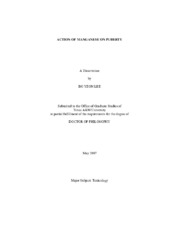Action of manganese on puberty
Abstract
Manganese (Mn) is considered important for normal growth and reproduction. Because Mn can cross the blood brain barrier and accumulate in the hypothalamus, and because it has been suggested that infants and children are potentially more sensitive to Mn than adults, we wanted to determine the effects of Mn exposure on puberty-related hormones and the onset of puberty, and discern the site and mechanism of Mn action. We demonstrated that the central administration of manganese chloride (MnCl2) stimulated luteinizing hormone (LH) release in prepubertal rats. Incubation of medial basal hypothalamus (MBH) in vitro showed this effect was due to a Mn-induced stimulation of luteinizing hormone releasing hormone (LHRH). Further demonstration that this is a hypothalamic site of action was shown by in vivo blockade of LHRH receptors and the lack of a direct pituitary action of Mn to stimulate LH release in vitro. Chronic supplementation of low dose of MnCl2 caused elevated serum levels of LH, follicle stimulating hormone (FSH) and estradiol or testosterone. Importantly, Mn supplementation advanced the timing of puberty in both sexes. We investigated the mechanism by which Mn induces LHRH/LH release from the hypothalamus. Blocking the NMDA receptor, IGF1 receptor, or inhibiting nitric oxide synthase in vivo was ineffective in altering Mn-induced LH release. Dose-response, pharmacological blockade and nitrite assessments indicated that the lowest doses of Mn used stimulated LHRH release, but did not induce nitric oxide (NO) production, while only the highest dose of Mn stimulated NO. Conversely, a dose-dependent inhibition of Mn-induced LHRH release was observed in the presence of ODQ, a specific blocker of soluble guanylyl cyclase. Furthermore, Mn stimulated the release of cyclic GMP (cGMP) and LHRH from the same MBH, and a protein kinase G (PKG) inhibitor, KT5823, blocked Mn-induced LHRH release. Collectively, these data demonstrate that Mn can stimulate specific puberty-related hormones both acutely and chronically, and furthermore, suggest that low levels of Mn facilitate the normal onset of puberty. The principal action of Mn within the hypothalamus is to facilitate the activation of guanylyl cyclase, which subsequently stimulates the cGMP/PKG pathway resulting in the stimulation of prepubertal LHRH secretion.
Citation
Lee, Bo Yeon (2003). Action of manganese on puberty. Doctoral dissertation, Texas A&M University. Texas A&M University. Available electronically from https : / /hdl .handle .net /1969 .1 /5871.


